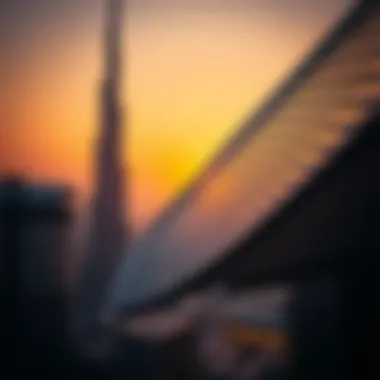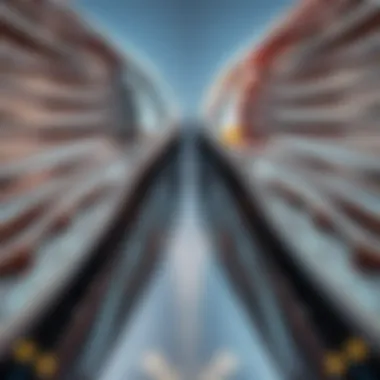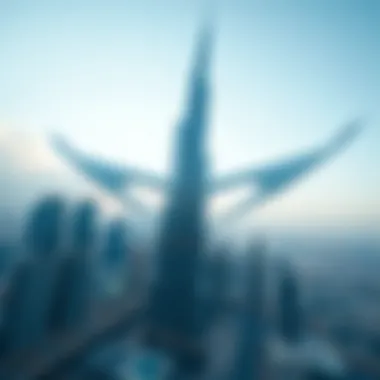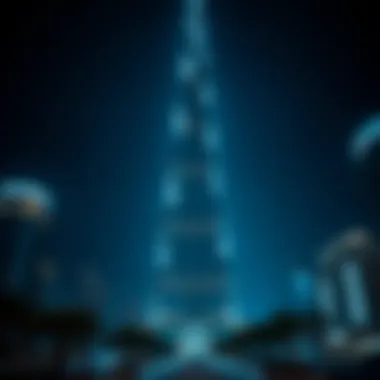Discovering the Wings of Burj Khalifa's Design


Intro
The Burj Khalifa stands tall as an iconic symbol of modern architecture and engineering prowess. However, it is the Wings of Burj Khalifa that deserve closer examination, because they represent a brilliant blend of aesthetic appeal and functional design. These wings not only enhance the structural integrity of the tower but also contribute significantly to Dubai’s skyline, saturating it with visual interest.
In this article, we will break down the unique architectural features of the Wings, explore the engineering techniques employed, and consider the broader implications on real estate trends and urban development in Dubai. By dissecting these elements, we aim to present a detailed view that will be particularly beneficial for homebuyers, investors, and anyone interested in the real estate landscape in this thriving city. Through our analysis, we hope to illuminate why understanding these wings is crucial for grasping the significance of the Burj Khalifa as more than just a tall building—it’s a cultural landmark that shapes the future of urban living.
As we delve deeper into the discussion, we will also look at how the Wings contribute to the financial landscape of the area, offering insights into current market trends and future projections. This multi-layered approach will equip readers with the knowledge they need to navigate the complexities of investing in this bustling market.
Prolusion to Burj Khalifa
The Burj Khalifa remains an iconic symbol of Dubai, representing not only architectural ingenuity but also the city’s aspirations for the future. With its height stretching over 828 meters, it dominates the skyline, serving as a beacon of modernism in an otherwise dynamic urban landscape. In this article, we will explore the wings of the Burj Khalifa, delving into their architectural marvels and what they signify in the grander scheme of Dubai's development and identity. Understanding the Burj Khalifa is crucial for homebuyers, investors, and developers alike, as it encompasses trends in luxury real estate and urban growth.
Historical Context
The inception of the Burj Khalifa can be traced back to early 2000, amidst Dubai's rapid development as a global city. Originally conceived as part of a larger development project known as Downtown Dubai, the tower aimed to attract tourism and present Dubai as a modern metropolis on the world stage. Designed by the architectural firm Skidmore, Owings & Merrill, the structure draws inspiration from traditional Islamic architecture, particularly the Hymenocallis flower. This connection to nature and culture etched significance into the skyline as it emerged.
Construction began in 2004 and reached completion in 2010, but the journey was not without hurdles. Logistical challenges and economic fluctuations happened during the process, further underscoring both the ambition and the vision behind the project. The dedication to completing the Burj Khalifa symbolized Dubai's resilience, illustrating the determination of city planners and builders to redefine urban living.
Architectural Significance
Architecturally, the Burj Khalifa is a marvel of modern engineering. Its unique design, characterized by three distinct wings, allows for increased stability and reduces wind resistance, crucial for such towering heights. The central core design concept not only enhances structural integrity but also creates a striking silhouette, reaching towards the heavens.
Moreover, the use of cutting-edge materials, like the high-performance glass and concrete employed throughout, showcases a combination of sustainability and elegance. The materials were selected to minimize energy consumption while maximizing both thermal comfort and visual appeal.
Of particular note is the incorporation of various public spaces, lush gardens, and observation decks that provide panoramic views of the surrounding landscape. These features are not just eye candy; they serve to connect inhabitants and visitors with Dubai’s rich natural environment, blending urban life with leisure.
"The Burj Khalifa serves as a cultural and architectural symbol of modernity, uniting historical elements with futuristic designs, making it a focal point for investors and residents alike."
Overall, understanding the architectural significance of the Burj Khalifa sets the foundation for appreciating the intricate elements of its wings and their impact on urban development in Dubai.
Understanding the Wings of Burj Khalifa
The Wings of Burj Khalifa symbolize not just innovation, but a quest to redefine architectural boundaries and modern living. Understanding these wings is crucial for anyone exploring the broader implications of this monumental structure. They play a significant role in determining the overall functionality and design cohesiveness of Burj Khalifa, impacting everything from urban planning to the aesthetics of Dubai’s skyline. As such, a thorough examination of the wings offers insight into not only their architectural merit, but also their contribution to real estate trends and urban life in Dubai.
Design Philosophy
The design philosophy behind the Wings of Burj Khalifa is deeply rooted in both cultural significance and functional necessity. The original architects aimed to symbolize a desert flower, and this ethos is manifest in the fluidity and curvature of the wings. Each angle, each line is intentional, designed to capture light and create a play of shadows that enhances the overall experience of the building.
Beyond aesthetics, the wings serve practical purposes. They house office spaces, residential apartments, and amenities that cater to a high-quality urban lifestyle. The open spaces near the base invite community interactions while the vertical extensions of the wings create a seamless blend between the ground and the sky. This philosophy of integration fosters not just visual impact but also practical utility and community engagement.
Structural Engineering
Marveling at the architectural beauty of Burj Khalifa is one part of the equation; the engineering that holds it all together deserves equal recognition. The wings are constructed using state-of-the-art materials like high-performance concrete and steel. This combination allows for formidable resistance to wind forces and seismic activities, two critical considerations for skyscrapers in dynamic environments.


One notable engineering feat is the incorporation of a central core that branches out into the wings. This layout not only provides structural integrity but also maximizes usable space within the building. Furthermore, advanced techniques in computer modeling and simulations were employed during the planning stages to pre-emptively identify potential weaknesses in the wings’ designs, ensuring that the final product could withstand the tests of time and nature.
Aesthetic Features
Visually, the wings add a new dimension to Burj Khalifa, standing out without overshadowing the main tower. The sleek, tapering lines of the wings create a sophisticated silhouette, while the glass facades reflect the sun’s rays in ever-changing patterns throughout the day. This dynamic visual appearance contributes to a sense of movement and vitality within Dubai’s skyline.
Interiorly, the wings feature elegant design elements that are consistent with the modern aesthetic of the overall structure. From the lobby areas that welcome visitors with a warm ambiance to the luxurious apartment layouts that boast panoramic views, these aesthetic choices are carefully curated. Art installations integrated into the design further elevate the cultural relevance of the space, linking the architectural experience with a local narrative that speaks to Dubai’s rapid growth and commitment to innovation.
Construction Process of the Wings
The construction process of the Wings of Burj Khalifa is not merely a technical endeavor; it is a narrative of innovation and resolve. This segment of the article highlights the intricate steps and considerations that went into realizing one of the tallest structures in the world. Understanding this process is crucial for homebuyers, investors, and real estate professionals eager to grasp the significance these wings hold within Dubai’s architectural narrative.
Key Materials Used
When it comes to such a monumental undertaking, the selection of materials is paramount. The primary material used in the Wings is reinforced concrete, known for its strength and durability. This concrete is not just any ordinary mix—it was specifically designed to withstand the extreme conditions of Dubai’s climate, including high temperatures and strong winds.
Additionally, glass plays a starring role in both functionality and aesthetics. The facade of the Wings utilizes high-performance glass that minimizes solar heat gain while maximizing views of the sprawling Dubai skyline. This choice not only enhances energy efficiency, thus appealing to environmentally-conscious investors, but it also contributes to the luxe feel that many high-end buyers desire.
Moreover, the elevators within the wings employ cutting-edge technology and materials to ensure swift transport between levels. Steel frameworks and advanced composites secure the structural integrity of these elements, making them crucial to the overall success of the project.
As such, the material choices serve a dual purpose of structural stability and visual appeal, both of which are essential not only for engineering but for attracting potential buyers and urban planners looking to understand the landscape of upscale living in Dubai.
Engineering Challenges
Building the Wings of Burj Khalifa was not without its fair share of challenges—think of it like piecing together a jigsaw puzzle where every piece is prone to shifting under weight. Among the most pressing issues faced was addressing the differential settling of various elements within the structure due to the sandy soil of Dubai. Engineers had to design the foundational system to accommodate these variances, employing deep foundations that sink into more stable strata beneath the surface.
Furthermore, the unique Y-shaped design brought forth its own array of complications. This geometry posed challenges during construction, necessitating sophisticated techniques to ensure each wing was leveled and aligned perfectly. The team had to devise a method of pouring concrete that allowed for a seamless transition between the base and the wings themselves.
Lastly, the integration of modern safety measures, including fire protection systems and evacuation routes, required innovation and adaptation on the fly, ensuring that the architects' ambitious vision did not compromise on safety.
Innovative Techniques
Innovation was the name of the game during the construction process of the Wings. One standout technique was the use of a jump form system, allowing for vertical construction that minimized the need for heavy scaffolding. This method not only saved time but also elevated efficiency, making it possible to reach higher floors more rapidly than traditional methods would allow.
Also noteworthy was the use of advanced simulation software that provided a virtual environment for planning. Engineers could model wind loads, structural responses, and other phenomena, which allowed them to anticipate and address potential issues long before they materialized on-site.
Automation played a significant role too, from how materials were delivered to processes within the worksite. Advanced robotics and machinery were employed to ensure precision in cutting and joining, resulting in a construction timeline that was nothing short of remarkable.
"The Wings of Burj Khalifa exemplify not only architectural beauty but also the incredible coordination of modern engineering practices."
In summary, the construction of the Wings of Burj Khalifa is an amalgamation of material choices, engineering prowess, and inventive approaches, each contributing to what stands today as a fixture in Dubai’s urban landscape. By grasping this construction narrative, investors and homebuyers can better appreciate the true value these wings represent.
The Role of the Wings in Urban Landscape
The Wings of Burj Khalifa serve as more than mere architectural add-ons; they are significant players in shaping the urban landscape of Dubai. This section focuses on how these wings not only complement the height and design of the tower but also influence the broader ecological and social fabric of the city. From aesthetics to functionality, the role of the wings underscores their importance in urban development in the heart of one of the world’s fastest-growing cities.


Impact on Dubai’s Skyline
When you glance at Dubai's skyline, the Burj Khalifa stands tall, a symbol of modern aspirations and a magnetic draw for tourists and professionals alike. The wings, which extend from the central core, imbue the skyscraper with a unique silhouette that instantly captures attention.
- Visual Dynamics: The wings break the uniformity of vertical lines, adding a sense of motion and fluidity. Their angular design fosters a dynamic visual experience, allowing viewers to see the structure from various perspectives, thus enhancing its presence in the skyline.
- Height Considerations: By extending outward, the wings not only physically broaden the building's base but also create a balanced visual weight within the towering structure. This is crucial, as it makes the overall design feel grounded, despite the sheer height of the tower.
- Urban Integration: The strategic placement of the wings minimizes shadowing effects that high-rise buildings typically cast. By doing so, they enable better light penetration to surrounding areas, promoting outdoor spaces and enhancing the aesthetic appeal of the urban environment.
In essence, the wings of Burj Khalifa serve as architectural features that elegantly enhance its status within the Dubai skyline. They contribute to a visual narrative that reflects both tradition and cutting-edge design, further enriching the urban atmosphere.
Symbolism and Identity
The wings of Burj Khalifa resonate deeply with the identity of Dubai itself. They are not just architectural features; they reflect the aspirations and ambitions of a city on the rise.
- Cultural Representation: The design of the wings harkens back to the region's rich history. Inspired by traditional Islamic architecture, they symbolize the meeting of culture and modernity, portraying Dubai as a contemporary cosmopolitan center while honoring its roots.
- Emblem of Progress: The wings signify the ambition of Dubai to position itself on the global stage. They embody the city’s story of transformation—from a modest trading port to a bustling metropolis. Each wing articulates a vision of progress, aligning with the Emirate's commitment to innovation.
- Collective Identity: The architectural integrity brought forth by the wings contributes to a shared identity among residents and visitors alike. They become a landmark not just for its height but for what it stands for—community, resilience, and a forward-looking spirit.
"The Wings of Burj Khalifa are a testament to Dubai's relentless pursuit of excellence and an enduring symbol of ambition in the face of challenges."
In summary, the wings are not stand-alone elements; they are interwoven symbols of Dubai's identity and aspirations. Whether viewed as enhancements to the architectural marvel or as cultural narratives depicting the spirit of the city, they play an indispensable role in defining the urban landscape of Dubai.
Real Estate Implications
The architectural prowess of the Wings of Burj Khalifa stretches beyond their impressive facade and engineering marvels. It resonates in the urban fabric of Dubai, weaving significant traits into the city's real estate landscape. The implications of the Wings on real estate are multifaceted; understanding these aspects could guide potential investors and homebuyers in making informed decisions.
Market Trends Post-Construction
Since the completion of Burj Khalifa and its innovative Wings, the landscape of Dubai's real estate has undergone noteworthy shifts. The erection of such a striking landmark has had a catalyzing effect on property market dynamics in the vicinity.
The Wings have not only elevated the profile of the surrounding neighborhoods but have also driven an increase in demand for real estate offerings. For instance, developments near the Burj Khalifa see heightened interest from both domestic and international buyers. Market analysts have observed that properties within close proximity to this architectural wonder have enjoyed a significant appreciation in value that often outpaces other areas in Dubai.
- Increased Investment: Investors are flocking to properties near the Burj Khalifa. The prestige associated with living in such a magnificent building attracts homebuyers looking for luxury as well as potential for growth in a rapidly developing market.
- Rental Demand Surge: The rental market saw a similar spike, resulting in increasing yields for landlords. With tourism on the rise, many units serve as high-demand short-term rentals.
- Commercial Growth: Businesses have also capitalized on the rise in foot traffic. Retail spaces and offices in the vicinity have seen a surge in interest, enabling higher rental rates and occupancy levels.
Property Values in Proximity
Living close to the Wings of Burj Khalifa is not just about aesthetic appeal; it can come with substantial financial benefits as well.
Several studies indicate that properties within a one-kilometer radius of the Burj Khalifa exhibit higher property values compared to other districts. This can be attributed to a combination of factors:
- Highly Sought-After Location: Locations associated with internationally recognized landmarks tend to draw buyers, leading to premium pricing.
- Luxury Amenities: Developments in the area often feature high-end amenities — fitness centers, rooftop views, and exclusive community services — which further justify elevated prices.
- Market Resilience: Even amid economic fluctuations, properties nearby the Burj Khalifa maintain relative stability in value, making them a safer investment option.
Future Developments in Dubai
As we gaze toward the horizon, the future of Dubai's skyline continues to evolve. The burrowing economical and infrastructural advancements surrounding the Wings of Burj Khalifa suggest a bright outlook for upcoming real estate ventures.
Anticipated projects around the landmark indicate:


- Mixed-Use Developments: New projects are expected that integrate residential, commercial, and even entertainment venues, creating vibrant communities that appeal to diverse demographics.
- Sustainable Initiatives: Future constructions are likely to follow the growing trend of sustainability, aiming to reduce carbon footprints and incorporate green technology.
- Accessibility Enhancements: As urban planners enhance infrastructure, including public transport links, ease of access to and from the Wings will further boost its desirability.
"The Wings of Burj Khalifa will continue to shape Dubai’s market. Investors should keep an eye on ongoing developments around this iconic landmark."
In summary, the architectural significance of the Wings of Burj Khalifa intertwines deeply with the real estate market of Dubai. For homebuyers and investors, recognizing the implications of this progress could pave the way for strategic real estate decisions.
Tourism and Cultural Significance
Tourism plays a central role in the vibrancy and appeal of the Wings of Burj Khalifa. This architectural wonder doesn't just serve as a functional building; it stands as a symbol of Dubai’s rapid development, cultural pride, and architectural innovation. For a city that has transformed from a modest fishing settlement to a global metropolis, the Wings encapsulate this journey beautifully. Tourists flock not only to see the towering structure but to engage with the culture that surrounds it.
Attracting Tourists
The Wings of Burj Khalifa attract millions of visitors each year, making it one of the most visited landmarks in the world. Its allure is multifaceted. Firstly, the sheer height is staggering, with an observation deck giving a panoramic view that leaves many breathless. The experience of being on the tallest building in the world is something that visitors can't easily forget.
But it’s not just the height that draws in crowds. The design is a mix of modernity and tradition, showcasing Islamic architecture in a contemporary setting. The carefully planned gardens and water features at its base also beckon tourists, providing a serene contrast to the bustling city around. Here are some factors that contribute to its tourism appeal:
- Iconic Status: Being part of the Burj Khalifa, the Wings carry the status and prestige of being among the most recognized landmarks globally.
- Cultural Engagement: Many tourists come looking for a cultural experience, which is readily available through local art displays and exhibitions held in the vicinity.
- Unique Experiences: Attractions like dining in high-end restaurants located within the wings, as well as guided tours, add extra value to the visitor's experience.
Cultural Events and Activities
In addition to drawing tourists for visual experiences, the Wings of Burj Khalifa host a variety of cultural events and activities. These gatherings often showcase the uniqueness of Emirates culture, helping visitors gain a deeper understanding of Dubai’s heritage. Events range from art exhibitions to music festivals, which not only entertain but also educate.
Some notable events include:
- Art Installations: Local artists are often invited to display their work, transforming the wings into a gallery that promotes Emirati art.
- Seasonal Celebrations: Special events for Eid, New Year’s Eve, and other holidays involve dazzling light shows that illuminate the skyline, reinforcing the space as a cultural gathering point.
- Workshops and Classes: Various classes related to traditional Emirati crafts are often organized, inviting both visitors and local residents to participate, fostering community interaction.
"The Wings of Burj Khalifa don’t just define a skyline; they narrate a story—a blending of tradition and innovation that resonates with everyone who visits."
Ultimately, the tourism and cultural significance of the Wings of Burj Khalifa is profound. They stand not just as a marvel of modern architecture, but as a hub of cultural interaction and engagement, contributing to both local and international community growth. For homebuyers, investors, and those interested in real estate, understanding this significance offers insights into the vibrancy of life surrounding this monumental structure.
For further insight on tourism and cultural events in Dubai, you may check Visit Dubai, alongside resources on Emirati culture available at Encyclopedia Britannica and local governmental resources.
Closure
The significance of the Wings of Burj Khalifa extends beyond their striking aesthetic and intricate engineering; they encapsulate a cultural and economic narrative that resonates deeply within Dubai and the world. In this section, we bring into focus the importance of the conclusions drawn in the preceding discussions, particularly surrounding architectural brilliance, urban integration, and the influence on real estate.
Summary of Key Points
In revisiting the salient points discussed throughout the article, it is vital to acknowledge the multifaceted role that the Wings play in the architectural landscape of Dubai:
- Innovative Design: The wings are not merely functional; they are a testament to cutting-edge design philosophies that prioritize both beauty and utility.
- Structural Integrity: The engineering feats achieved in the construction of these wings are reflective of advancements in materials and techniques, which have set benchmarks for future skyscrapers.
- Cultural Symbol: Beyond their physical presence, the wings contribute to a sense of identity, serving as an emblem of modernity and progress in a city that thrives on innovation.
- Real Estate Impact: The development surrounding the Burj Khalifa has experienced a ripple effect, enhancing property values and attracting investors, thus shaping Dubai’s real estate market.
With these points in mind, it's clear that the Wings of Burj Khalifa serve a diverse array of purposes that go beyond the mere visual spectacle. They stand as a critical element in the formation of Dubai’s global identity.
Future Perspectives
Looking forward, the evolution of the Wings deems pivotal for prospective homebuyers, investors, real estate agents, and urban developers. Several aspects to consider include:
- Sustainability Initiatives: As Dubai ventures into a more sustainable future, the wings could pioneer integration with green technologies, inspiring other structures worldwide to adapt.
- Cultural Events: Increased focus on utilizing the wings for cultural events may further solidify Dubai's position as a cultural hub, increasing tourism and local engagement.
- Market Adaptations: As the real estate landscape changes, potential investors should keenly observe how the proximity to such iconic architecture influences housing demands and prices.
Anticipating these developments ensures that stakeholders remain informed and adept at leveraging opportunities that arise from the architectural marvel that is the Wings of Burj Khalifa. With adaptive strategies, Dubai could sustain its allure, making it an enduring beacon for architectural innovation and investment.











